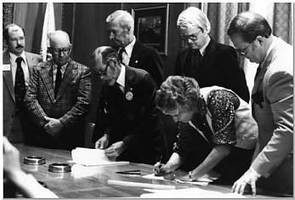Prior to 1955, Westminster obtained water for its  residents solely from ground wells. The rapid growth during the 1950s put a strain on Westminster's water supply. The city attempted to purchase water from Denver, but was outside of the "blue line," the boundary denoting the area that the Denver Water Board could serve.
residents solely from ground wells. The rapid growth during the 1950s put a strain on Westminster's water supply. The city attempted to purchase water from Denver, but was outside of the "blue line," the boundary denoting the area that the Denver Water Board could serve.
The city made several surface water purchases during the 1950s, including the Kershaw Ditch and shares in the Farmer's Highline Canal, and built England water treatment plant in 1956. In 1957, they entered into a 25-year contract with Northwest Water Corporation for well water. By 1959, the water treatment plant had to be expanded to twice its original capacity to provide drinking water to the residents of Westminster.
Things were going well for Westminster until the early 1960s when water quality problems prevented the use of the Kershaw Ditch Water. With the loss of the water provided by the ditch, the city's water supply was stressed. In 1962, water rights on Coal Creek were purchased and construction of the Twin Lakes reservoir was scheduled to be completed in 1963.
However, the "Long Hot Summer of 1962" intervened. Extreme weather conditions during the summer forced the city to begin using the "safe, but stinky" Kershaw Ditch Water in order to keep up with demand. Finally, on a hot afternoon in late summer, a group of housewives gathered for what is still known as the "Mother's March on City Hall." Armed with signs and posters, the women paraded around City Hall for television cameras and reporters from the metropolitan daily newspapers demanding "safe" water for their children.
A citizens committee demanded that Westminster discontinue using the ditch water source, stop issuing building permits, ban lawn sprinkling and go to the Denver Water board to secure a source of water for the city. The Denver Water Board in turn required the abandonment of Westminster's own water supply as a condition to providing water to the suburb. City leaders felt that Westminster had too much invested in its water supply to just give it up. Additionally, any request for new water service would have to be approved by the Denver Water Board.
The battle continued into the fall of 1962. Every City Council meeting was an occasion for requests and demands for information and a decision regarding the water supply. In November, negotiations were opened with the Farmer's Reservoir and Irrigation Company (FRICO) for storage rights in Standley Lake, and the work on the Twin Lakes project was postponed. Finally, an agreement was reached with FRICO in January 1963, calling for the Standley Lake Dam to be raised to hold an additional 24,000 acre feet of water, half of which would be for use by the City of Westminster.
The referendum for Denver water went to the people in March 1963, with 1,997 voters upholding the city's position, and 1,827 voting to purchase Denver water. A $3.5 million bond issue for water system improvements was approved in June 1963. A second referendum on Denver water failed three weeks later. By 1965, Westminster had a surplus of water. The City Charter was amended to allow water to be sold outside of the city. Contracts were signed to provide water to the unincorporated area of Shaw Heights and the City of Federal Heights.
Standley Lake was enlarged between 1965 and 1967. To treat the additional water, Semper Water Treatment Facility was built in 1969 to process six million gallons of water per day. After four expansions, Semper now treats 44 million gallons of water per day.
Westminster continued to protect its water supply through the years. A Growth Management Plan was adopted and agreements with other area governments ensured that the city would continue to provide high quality water to its residents.
During the early 1970s, the city's water problems resurfaced. The nearby city of Thornton, desperately in need of water, took action to condemn water rights belonging to the Farmer's Reservoir and Irrigation Company (FRICO), and later the Farmer's Highline Canal and Reservoir Company.
Westminster, in order to protect its own future water supply, filed condemnation suits of its own.
Meanwhile, the city of Northglenn was negotiating to break away from the Thornton water system to develop one of its own. They were seeking a large scale reuse program with FRICO.
The four entities, all with substantial interests in Standley Lake, became entwined in numerous legal battles and disagreements.
A four-way agreement was drafted and finalized in 1979 as a means of ending litigation and forming a cooperative atmosphere on all water matters. The agreement was historic in nature because of the cooperation it represented between the agricultural and municipal communities.